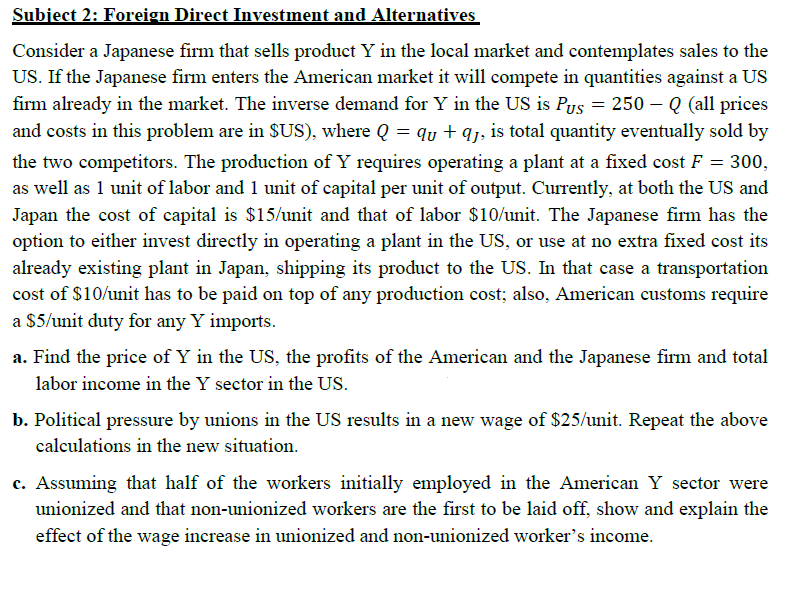Consider a Japanese firm that sells product Y in the local market and contemplates sales to the US. If the Japanese firm enters the American market it will compete in quantities against a US firm already in the market. The inverse demand for Y in the US is Pus = 250 - Q (all prices and costs in this problem are in $US), where Q = qu + q1, is total quantity eventually sold by the two competitors. The production of Y requires operating a plant at a fixed cost F = 300, as well as 1 unit of labor and 1 unit of capital per unit of output. Currently, at both the US and Japan the cost of capital is $15/unit and that of labor $10/unit. The Japanese firm has the option to either invest directly in operating a plant in the US, or use at no extra fixed cost its already existing plant in Japan, shipping its product to the US. In that case a transportation cost of $10/unit has to be paid on top of any production cost; also, American customs require a $5/unit duty for any Y imports.
Consider a Japanese firm that sells product Y in the local market and contemplates sales to the US. If the Japanese firm enters the American market it will compete in quantities against a US firm already in the market. The inverse demand for Y in the US is Pus = 250 - Q (all prices and costs in this problem are in $US), where Q = qu + q1, is total quantity eventually sold by the two competitors. The production of Y requires operating a plant at a fixed cost F = 300, as well as 1 unit of labor and 1 unit of capital per unit of output. Currently, at both the US and Japan the cost of capital is $15/unit and that of labor $10/unit. The Japanese firm has the option to either invest directly in operating a plant in the US, or use at no extra fixed cost its already existing plant in Japan, shipping its product to the US. In that case a transportation cost of $10/unit has to be paid on top of any production cost; also, American customs require a $5/unit duty for any Y imports.
Chapter15: Imperfect Competition
Section: Chapter Questions
Problem 15.10P: Inverse elasticity rule Use the first-order condition (Equation 15.2 ) for a Cournot firm to show...
Related questions
Question

Transcribed Image Text:Subject 2: Foreign Direct Investment and Alternatives
Consider a Japanese firm that sells product Y in the local market and contemplates sales to the
US. If the Japanese firm enters the American market it will compete in quantities against a US
firm already in the market. The inverse demand for Y in the US is Pus = 250 – Q (all prices
and costs in this problem are in $US), where Q = qy + qj, is total quantity eventually sold by
the two competitors. The production of Y requires operating a plant at a fixed cost F = 300,
as well as 1 unit of labor and 1 unit of capital per unit of output. Currently, at both the US and
Japan the cost of capital is $15/unit and that of labor $10/unit. The Japanese firm has the
option to either invest directly in operating a plant in the US, or use at no extra fixed cost its
already existing plant in Japan, shipping its product to the US. In that case a transportation
cost of $10/unit has to be paid on top of any production cost; also, American customs require
a $5/unit duty for any Y imports.
a. Find the price of Y in the US, the profits of the American and the Japanese firm and total
labor income in the Y sector in the US.
b. Political pressure by unions in the US results in a new wage of $25/unit. Repeat the above
calculations in the new situation.
c. Assuming that half of the workers initially employed in the American Y sector were
unionized and that non-unionized workers are the first to be laid off, show and explain the
effect of the wage increase in unionized and non-unionized worker's income.
Expert Solution
This question has been solved!
Explore an expertly crafted, step-by-step solution for a thorough understanding of key concepts.
This is a popular solution!
Trending now
This is a popular solution!
Step by step
Solved in 2 steps

Knowledge Booster
Learn more about
Need a deep-dive on the concept behind this application? Look no further. Learn more about this topic, economics and related others by exploring similar questions and additional content below.Recommended textbooks for you


Managerial Economics: A Problem Solving Approach
Economics
ISBN:
9781337106665
Author:
Luke M. Froeb, Brian T. McCann, Michael R. Ward, Mike Shor
Publisher:
Cengage Learning

Economics: Private and Public Choice (MindTap Cou…
Economics
ISBN:
9781305506725
Author:
James D. Gwartney, Richard L. Stroup, Russell S. Sobel, David A. Macpherson
Publisher:
Cengage Learning


Managerial Economics: A Problem Solving Approach
Economics
ISBN:
9781337106665
Author:
Luke M. Froeb, Brian T. McCann, Michael R. Ward, Mike Shor
Publisher:
Cengage Learning

Economics: Private and Public Choice (MindTap Cou…
Economics
ISBN:
9781305506725
Author:
James D. Gwartney, Richard L. Stroup, Russell S. Sobel, David A. Macpherson
Publisher:
Cengage Learning

Microeconomics: Private and Public Choice (MindTa…
Economics
ISBN:
9781305506893
Author:
James D. Gwartney, Richard L. Stroup, Russell S. Sobel, David A. Macpherson
Publisher:
Cengage Learning